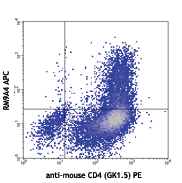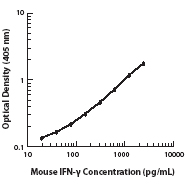- Clone
- RM9A4 (See other available formats)
- Regulatory Status
- RUO
- Other Names
- Interleukin-9, P40, Mast cell growth factor (MCGF), Megakaryoblast growth factor, T cell growth factor-3 (TCGF-3)
- Isotype
- Rat IgG1, κ
- Ave. Rating
- Submit a Review
- Product Citations
- publications

-

-

-

FACS sorted naive CD4 T cells (CD44lo, CD25-) were cultured on plates coated with 1 µg/ml anti-CD3 and 10 µg/ml anti-CD28 in the presence of 10 ng/ml IL-4 and 5 ng/ml TGFβ for 3 days. Intracellular staining was performed following a 4h restimulation with PdBU/ionomycin/brefeldin. Data kindly provided by: Dr. Brigitta Stockinger, PhD
| Cat # | Size | Price | Quantity Check Availability | Save | ||
|---|---|---|---|---|---|---|
| 514103 | 25 µg | 147€ | ||||
| 514104 | 100 µg | 278€ | ||||
IL-9 is a potent, T cell-derived, T cell growth factor which can also enhance mast cell activity and IL-3- or IL-4- dependent proliferation of bone marrow-derived mast cells. IL-9 synergizes with erythropoietin to promote erythroid colony formation. IL-9 induces high affinity IgE receptor expression and granzyme A and B in murine T helper clones.
Product DetailsProduct Details
- Verified Reactivity
- Mouse
- Antibody Type
- Monoclonal
- Host Species
- Rat
- Immunogen
- Recombinant full length mouse IL-9
- Formulation
- Phosphate-buffered solution, pH 7.2, containing 0.09% sodium azide.
- Preparation
- The antibody was purified by affinity chromatography, and conjugated with PE under optimal conditions.
- Concentration
- 0.2 mg/ml
- Storage & Handling
- The IL-9 antibody solution should be stored undiluted between 2°C and 8°C, and protected from prolonged exposure to light. Do not freeze.
- Application
-
ICFC - Quality tested
- Recommended Usage
-
Each lot of this antibody is quality control tested by intracellular immunofluorescent staining with flow cytometric analysis. For flow cytometric staining, the suggested use of this reagent is ≤0.25 µg per million cells in 100 µl volume. It is recommended that the reagent be titrated for optimal performance for each application.
- Excitation Laser
-
Blue Laser (488 nm)
Green Laser (532 nm)/Yellow-Green Laser (561 nm)
- Application Notes
-
See the protocol for Th9 polarization of mouse splenocytes.
- Application References
- Product Citations
-
- RRID
-
AB_2126639 (BioLegend Cat. No. 514103)
AB_2562527 (BioLegend Cat. No. 514104)
Antigen Details
- Structure
- Cytokine; 30-40 kD (Mammalian)
- Bioactivity
- Potentiates production of IgG, IgM, and IgE by IL-4-induced B lymphocytes; regulates granzyme family proteases; enhances proliferation of bone marrow mast cells with IL-3; production of IL-6 by mast cells
- Cell Sources
- IL-2 activated TH2 lymphocytes
- Cell Targets
- T lymphocytes, erythroid precursors
- Receptors
- IL-9R
- Biology Area
- Immunology
- Molecular Family
- Cytokines/Chemokines
- Antigen References
-
1. Fitzgerald K, et al. Eds. 2001. The Cytokine FactsBook. Academic Press San Diego.
2. Quesniaux V, et al. 1992. Research Immunology 143:385.
3. Renauld J, et al. 1993. Adv. Immunol. 54:79.
4. Yang Y, et al. 1992. Leuk. Lymphoma 8:441. - Regulation
- Upregulated by IL-1 after TCR activation, TNF-α; downregulated by antibodies to IL-2
- Gene ID
- 16198 View all products for this Gene ID
- UniProt
- View information about IL-9 on UniProt.org
Related FAQs
- What type of PE do you use in your conjugates?
- We use R-PE in our conjugates.
Other Formats
View All IL-9 Reagents Request Custom Conjugation| Description | Clone | Applications |
|---|---|---|
| PE anti-mouse IL-9 | RM9A4 | ICFC |
| Purified anti-mouse IL-9 | RM9A4 | ELISA |
| APC anti-mouse IL-9 | RM9A4 | ICFC |
| Alexa Fluor® 647 anti-mouse IL-9 | RM9A4 | ICFC |
| Brilliant Violet 421™ anti-mouse IL-9 | RM9A4 | ICFC |
| PerCP/Cyanine5.5 anti-mouse IL-9 | RM9A4 | ICFC |
Customers Also Purchased


Compare Data Across All Formats
This data display is provided for general comparisons between formats.
Your actual data may vary due to variations in samples, target cells, instruments and their settings, staining conditions, and other factors.
If you need assistance with selecting the best format contact our expert technical support team.
-
PE anti-mouse IL-9


FACS sorted naive CD4 T cells (CD44lo, CD25-) were cultured ... 
-
Purified anti-mouse IL-9
-
APC anti-mouse IL-9

CD4+ T cells from C57BL/6 mouse were cultured with anti-mous... 
-
Alexa Fluor® 647 anti-mouse IL-9

CD4+ T cells from C57BL/6 mouse were cultured with anti-mous... 
-
Brilliant Violet 421™ anti-mouse IL-9

Enriched C57BL/6 mouse CD4+ T cells were cultured with anti-... 
-
PerCP/Cyanine5.5 anti-mouse IL-9

Enriched C57BL/6 mouse CD4+ T cells were stimulated with ant...
 Login / Register
Login / Register 
















Follow Us